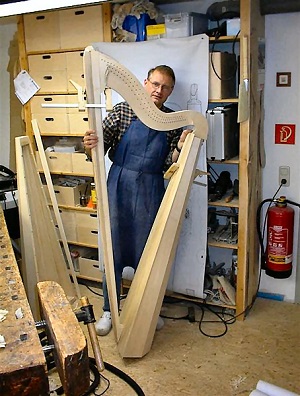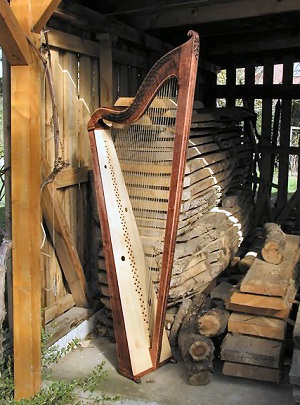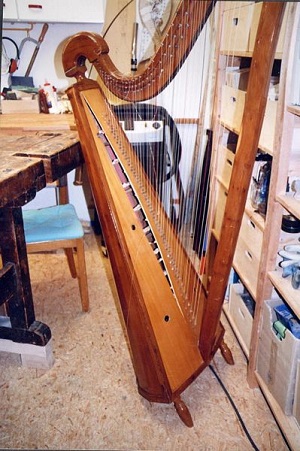 Harps from my workshop are made from European timber. I keep a stock of maple, pear-tree, ash, cherry-tree, plum-tree, walnut, willow, spruce, cedar.
Harps from my workshop are made from European timber. I keep a stock of maple, pear-tree, ash, cherry-tree, plum-tree, walnut, willow, spruce, cedar.
Sound-boards are made from various materials, such as spruce, cedar, maple and willow, depending on the period in which the original was made and on the customer’s requirements.
The sound-board is the heart of an instrument and its making requires very careful attention.
 For me it is always an uplifting moment when the pillar, neck and body come together for the first time.
For me it is always an uplifting moment when the pillar, neck and body come together for the first time.
Detail Work
Shaping the frame, adding and shaping the shoulder, crafting of the wood surface. Carved ornamentation makes a harp particularly special.
Bands
Traditional hand-drawn banding for the edges. The bands require exact craftsmanship to fit them to the harp and they add a special flair.
Bray Pins
Bray pins for mediaeval and hook harps must be individually crafted. Only if they function well can they be used appropriately by the player.
Refinement
The instrument is treated with stains, oil, wax or shellac to give it its final optical character. Light shadows are applied to the carved ornamentation. On request your instrument can be antiquated using various techniques to give it a historical appearance.
Harp Strings
The strings bring the instrument to life. Now the results of many weeks’ work are revealed. I pay attention to a balanced sound with the appropriate character.
Completion
From raw material (timber) to the finished instrument: After about nine weeks of concentrated work a large triple harp is completed, ready for its owner.
 Harp Repair
Harp Repair
It is always tragic when a loved instrument is unexpectedly damaged, due to age or an accident. However, what may at first seem a hopeless case is often reparable.
As an example, here I show the replacement of the sound-board of a Welsh triple harp made in 1984. At the same time I cleaned and adjusted all the metal tuning pegs and repaired areas of damaged varnish. The instrument is now in excellent condition for many years to come..
Harp Restoration
Restoration is a very demanding business. The highest priority is to reconstruct the original condition of the instrument without wiping away the traces of its lifetime.
For me every antique comes to life through its signs of wear. Particularly the repair of surfaces requires a great deal of experience from the restorer. For old harps the focus is on restoration of functional capability and safeguarding of the construction.
Restoration of an Erat double-action pedal harp from 1845 / England
Old pedal harps are often in a regrettable condition when clients ask me to restore them. The instruments are now about 200 years old and were manufactured in an excellent fashion, invaluable by today’s standards. The sound of these early pedal harps is always of very high quality after restoration.
Here I dewormed the complete pedal box and the lower resonance body. I had to remove gnawed wood and then rebuild the missing sections. The mechanism was also completely gummed up due to machine oil; individual axle pins of the mechanism and fork pins of the turntables were missing. Finally I had to rebuild missing stucco ornaments. With a historical, light stringing the instrument has been fully functional again for many years now.
